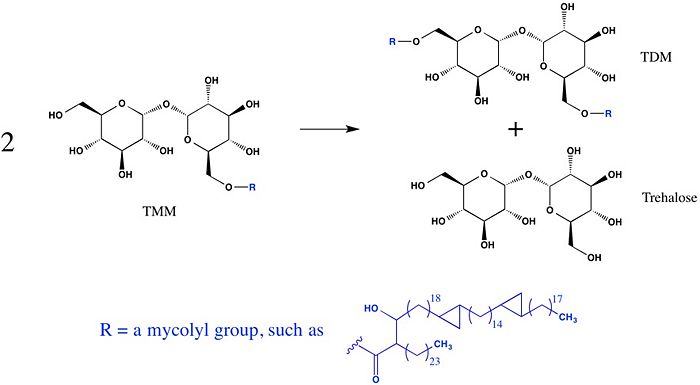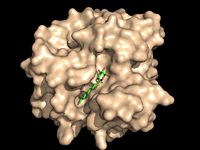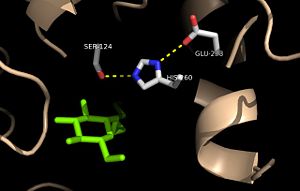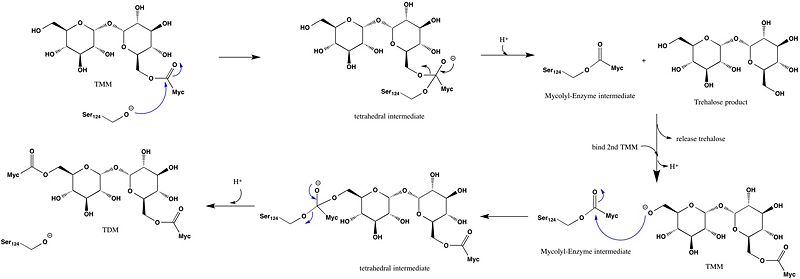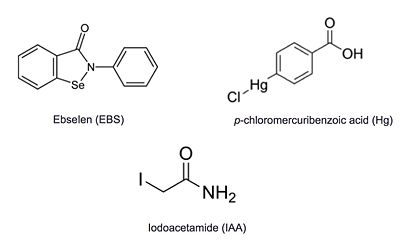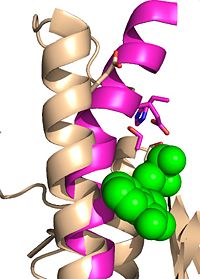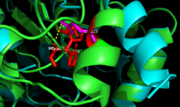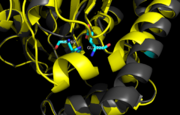Sandbox Reserved 1051
From Proteopedia
(Difference between revisions)
| Line 36: | Line 36: | ||
==Structures of Variant Enzymes== | ==Structures of Variant Enzymes== | ||
===Covalent Modification of Cys209=== | ===Covalent Modification of Cys209=== | ||
| + | Ag85C has been crystallized following covalent inhibition by several thiol-modifying agents [http://en.wikipedia.org/wiki/4-Chloromercuribenzoic_acid p-chloromercuribenzoic acid] and [http://en.wikipedia.org/wiki/Iodoacetamide iodoacetamide]. The structures show that each of these thiol-reactive inhibitors covalently bound to C209 and caused a relaxation of the α9 helix. | ||
| + | |||
| + | [[Image:Inhibitors_Ag85c.jpeg|400 px|center|thumb|'''Figure 6:''' Known thiol-reactive inhibitors of Ag85C]] | ||
[[Image:Ebselen_inhibition.jpeg|200 px|right|thumb|'''Figure 5:''' Ebselen inhibition relaxing the alpha-9 helix in [http://www.rcsb.org/pdb/explore/explore.do?structureId=4qdu Ag85C-Ebselen]]] | [[Image:Ebselen_inhibition.jpeg|200 px|right|thumb|'''Figure 5:''' Ebselen inhibition relaxing the alpha-9 helix in [http://www.rcsb.org/pdb/explore/explore.do?structureId=4qdu Ag85C-Ebselen]]] | ||
Ag85C can be inhibited by [http://en.wikipedia.org/wiki/Ebselen ebselen], which covalently bounds to the sulfur in C209. Ebselen is a thiol-modifying agent that serves as an electrophile for a C209 nucleophilic attack that results in sulfur-selenium bond formation. Co-crystallization of ebselen with Ag85C provides an explanation for the mechanism of ebselen-based inhibition. The addition of ebselen increases the distance between C209 and L232-T231, which effectively disrupts the interaction that holds the α9 helix in the active conformation. The disruption of this interaction causes the α9 helix to <scene name='69/694220/Inhibited_relaxed_helix/1'>relax</scene>. Furthermore, the bulk of ebselen creates steric hindrance with the α9 helix residues, which can be seen in '''Figure 5'''. The pink helix represents the native enzyme, and the tan helix represents Ag85C covalently bound to ebselen, which is shown in green. Relaxation of the α9 helix due to ebselen removes E228 and H260, which now interacts with S148, from the active site. The absence of these residues destroys the charge relay mechanism, and as a result, the nucleophilicity of the S124 alcohol is not longer strengthened, which decreases serine hydrolytic activity. | Ag85C can be inhibited by [http://en.wikipedia.org/wiki/Ebselen ebselen], which covalently bounds to the sulfur in C209. Ebselen is a thiol-modifying agent that serves as an electrophile for a C209 nucleophilic attack that results in sulfur-selenium bond formation. Co-crystallization of ebselen with Ag85C provides an explanation for the mechanism of ebselen-based inhibition. The addition of ebselen increases the distance between C209 and L232-T231, which effectively disrupts the interaction that holds the α9 helix in the active conformation. The disruption of this interaction causes the α9 helix to <scene name='69/694220/Inhibited_relaxed_helix/1'>relax</scene>. Furthermore, the bulk of ebselen creates steric hindrance with the α9 helix residues, which can be seen in '''Figure 5'''. The pink helix represents the native enzyme, and the tan helix represents Ag85C covalently bound to ebselen, which is shown in green. Relaxation of the α9 helix due to ebselen removes E228 and H260, which now interacts with S148, from the active site. The absence of these residues destroys the charge relay mechanism, and as a result, the nucleophilicity of the S124 alcohol is not longer strengthened, which decreases serine hydrolytic activity. | ||
Revision as of 17:38, 15 June 2015
| This Sandbox is Reserved from 02/09/2015, through 05/31/2016 for use in the course "CH462: Biochemistry 2" taught by Geoffrey C. Hoops at the Butler University. This reservation includes Sandbox Reserved 1051 through Sandbox Reserved 1080. |
To get started:
More help: Help:Editing |
Trehalose-O-mycolyltransferase Ag85C
Introduction
Antigen 85C is one of three homologous protein components of the Ag85 complex in the cell wall of M. tuberculosis. This serine esterase enzyme catalyzes the transfer of mycolyl groups, characteristic components of the cell wall of mycobacteria. Several three dimensional structures of Ag85C have been solved, including the wild type enzyme as well as active site variants due to site-directed mutagenesis and covalent modification.
| |||||||||||
References
- ↑ Jackson M, Raynaud C, Laneelle MA, Guilhot C, Laurent-Winter C, Ensergueix D, Gicquel B, Daffe M. Inactivation of the antigen 85C gene profoundly affects the mycolate content and alters the permeability of the Mycobacterium tuberculosis cell envelope. Mol Microbiol. 1999 Mar;31(5):1573-87. PMID:10200974
- ↑ Ronning DR, Klabunde T, Besra GS, Vissa VD, Belisle JT, Sacchettini JC. Crystal structure of the secreted form of antigen 85C reveals potential targets for mycobacterial drugs and vaccines. Nat Struct Biol. 2000 Feb;7(2):141-6. PMID:10655617 doi:10.1038/72413
- ↑ Ronning DR, Vissa V, Besra GS, Belisle JT, Sacchettini JC. Mycobacterium tuberculosis antigen 85A and 85C structures confirm binding orientation and conserved substrate specificity. J Biol Chem. 2004 Aug 27;279(35):36771-7. Epub 2004 Jun 10. PMID:15192106 doi:http://dx.doi.org/10.1074/jbc.M400811200
- ↑ Favrot L, Lajiness DH, Ronning DR. Inactivation of the Mycobacterium tuberculosis Antigen 85 complex by covalent, allosteric inhibitors. J Biol Chem. 2014 Jul 14. pii: jbc.M114.582445. PMID:25028518 doi:http://dx.doi.org/10.1074/jbc.M114.582445
- ↑ Cite error: Invalid
<ref>tag; no text was provided for refs namedFavrot
